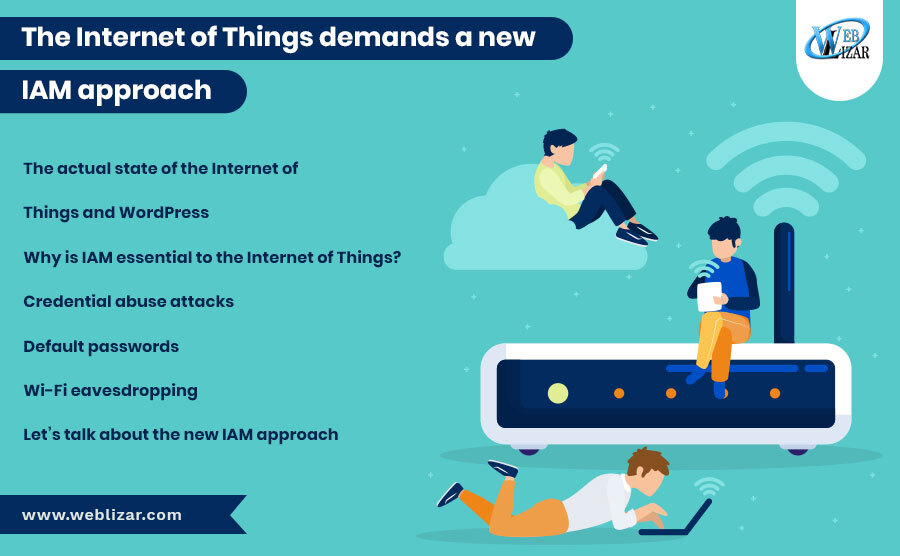The Internet of Things, IoT for short, has affected our lives in both visible and invisible ways, experiencing considerable growth in consumer and business environments. Almost everything is connected to the World Wide Web management these days. Wearable fitness trackers run on data, collecting information about the number of steps or the heart rate. But let’s not forget about outstanding technology evolutions such as Kubernetes, which enable flexibility in terms of cloud-based applications. The Internet of Things has entered the territory of web development only to make users more interactive with websites with a leaning of innovation.
The Actual state of the Internet of Things and WordPress
There’s a close relationship between devices and people, devices and devices, devices and applications/services, and people and applications/services. By combining several devices with automated systems, it’s possible to gain valuable info, analyze it, and create an action plan. What connection could there be between IoT and real-world devices? Well, think about the times the bell goes off whenever there is a sale or comment on your website.
The aspects highlighted above may not seem as much, but it’s a lot in terms of IoT – WordPress interconnectivity. As time goes on, we’ll be able to add more interesting scenarios. The scale of opportunity doesn’t represent an exaggeration. At one point or another, every WordPress site will require greater connectivity. To make WordPress smart, APIs are essential for delivering data companies like MongoDB have already started making APIs capable of delivering data to between the end points of devices.
Why is IAM essential to the Internet of Things?
Organizations are already amassing impressive amounts of data from their operations, which stem from the activity of people or from connected gadgets. The way brands connect with consumers and how enterprises manage their operations have changed for good. Now more than ever. The IoT requires a new approach in terms of identity and access management. IAM – identity and access management, as we all know it – is right at the heart of the Internet of Things, safeguarding against breaches and malicious attacks.
The enhanced software control of the physical world translates into the use of tight, complex controls. The Internet of Things landscape remains immature and, if we may say so, haywire. Since everything can be accessed via the World Wide Web without much effort, numerous risks arise. The atypical hardware, uncommon operating systems, and proprietary network protocols are difficult to assess, let alone protect.
Credential abuse attacks
More and more cybercriminals are deploying APIs to bypass security controls. So, they steal credentials, such as usernames and passwords, to obtain access to sensitive data. The cyber-attacks represent a combination of API targeting and other methodologies. In the absence of a proper IAM solution, thieves can easily get access to the credentials and end up in places where they shouldn’t be. As opposed to malware exploits, which rely on weaknesses in the security system, credential abuse attacks rely on human interaction.
Default passwords
The main issue with IoT devices is that they come with default passwords for administrative access, which can be identified without great difficulty by cyber attackers because they are generally identical among all systems from a vendor or product line. Even those who make the effort of changing their passwords, opt for simple combinations of words and numbers. There’s a good thing that nowadays we have the necessary technology to make default IoT passwords obsolete.
Wi-Fi eavesdropping
In case you didn’t already know, the Wi-Fi network isn’t secure. Indeed, you can activate encryption to prevent unauthorized people from accessing the network, but there are still ways to eavesdrop on someone else’s traffic. IoT devices are connected to virtual assistants, which in turn collect priceless information. There’s no way of knowing if the company VA is leaking out information or not. Digital communications can be intercepted at any time.
Needless to say, there are other challenges associated with identity and access management in the IoT, but this isn’t the time or place for such a discussion.
Let’s talk about the new IAM approach
Identity and access management refers to a set of policies and technologies that provide the means to manage user authorizations based upon their roles within the organization. With an IAM framework in place, IT managers have the power to control critical information. Managing access to networks, data, and applications can’t be done without helpful tools. Every year, innovative products come onto the Identity and Access Management Market. In the era of the Internet of Things, it’s necessary to make a change.
It’s necessary to extend the responsibility from the specialized operations team to the development group. Indeed, there is a need for extensive training, but there is another solution at hand. To be more precise, it’s necessary to develop identity and access management policies according to best practices and governance standards. In this case, This will significantly reduce the risk of human error and ensures that resources are fully protected.
Transition To Identity Relationship Management
Some companies might want to consider making the transition to Identity Relationship Management, which, in some instances, is more suitable. The next generation of IAM, as it’s commonly referred to, is designed to check out identities and access privileges in real-time. It’s imperative to make the shift to a secure universe with a modernized workflow. Companies interested in making a change should look into available vendor solutions for IoT identity requirements. All in all, the Internet of Things provides access to great amounts of data. The role of identity and access management must include robust protection. Completely securing your IoT isn’t easy, but neither is it impossible.

